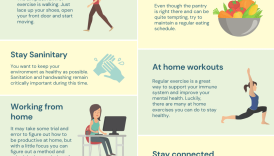The Ultimate Guide to Living a Well-Balanced Life

Introduction to Living a Well-Balanced Life
Definition of Well-Balanced Life
Living a well-balanced life means finding harmony among various aspects of one’s existence—such as work, relationships, health, and personal growth. It is about achieving a state where no single area overwhelms the others, allowing individuals to thrive holistically. Imagine a sturdy seesaw: when one side is loaded with too much weight, it tilts, creating an imbalance. In contrast, a well-balanced life is akin to that perfect seesaw evenly shared by friends, where joy and contentment prevail. But how do you know when you’re balanced? It might be when:
- The Ultimate Guide to Living a Well-Balanced Life
- Introduction to Living a Well-Balanced Life
- Definition of Well-Balanced Life
- Benefits of Living a Well-Balanced Life
- Importance of Physical Health in Maintaining Balance
- Regular Exercise
- Healthy Eating Habits
- Nurturing Mental Well-Being for a Balanced Life
- Stress Management Techniques
- Importance of Mental Health Days
- Creating Emotional Balance
- Building Healthy Relationships
- Practicing Mindfulness and Gratitude
- Balancing Work and Personal Life
- Time Management Strategies
- Setting Boundaries at Work and Home
- You feel energized at work and at home.
- You have time for hobbies, friends, and family.
- Your physical health and mental well-being appear to be in sync.
Benefits of Living a Well-Balanced Life
The perks of living a well-balanced life are plentiful and undeniable. From improved health to enhanced productivity, the benefits transcend mere convenience. Here are a few noteworthy advantages:
- Enhanced Mental Health: Striking a balance reduces stress and anxiety, encouraging a more peaceful mindset. Consider someone who blends their work and family time effectively; they are less likely to feel overwhelmed and more likely to approach life’s challenges with a clear head.
- Increased Productivity: When individuals maintain their physical and mental health, they can perform better at work. It’s like keeping a well-oiled machine; when everything is in tune, efficiency improves.
- Strong Relationships: Balance allows time for nurturing connections with family and friends. Relationships flourish when individuals prioritize them, leading to emotional support and companionship.
- Greater Life Satisfaction: A well-balanced life fosters a sense of fulfillment and joy. People often report feeling more satisfied with their daily lives when they can successfully juggle their responsibilities and leisure.
In sum, embarking on the journey toward a well-balanced life not only enhances one’s well-being but can also enrich every interaction and experience along the way. It’s about creating a life that resonates with harmony, leading to happier, healthier living.
Importance of Physical Health in Maintaining Balance
Regular Exercise
One of the pillars of living a well-balanced life is regular exercise, which plays a crucial role in maintaining both physical and mental wellness. Engaging in physical activity boosts serotonin levels—often referred to as the “feel-good” hormone—leading to reduced stress and anxiety. Picture this: after a long day, stepping onto a yoga mat or going for a brisk walk can transform your mood and clear your mind. Here are some effective ways to include regular exercise in your routine:
- Set Realistic Goals: Start small by aiming for 20-30 minutes of exercise three times a week and gradually build up from there.
- Find Activities You Enjoy: Whether it’s dancing, swimming, or simply taking long walks, enjoying what you do makes exercising less of a chore.
- Make it a Habit: Consider scheduling workouts as you would any important meeting. Consistency is key for long-term benefits.
Incorporating exercise not only enhances physical fitness but also fosters a sense of accomplishment, leading to a more balanced and fulfilling life.
Healthy Eating Habits
Equally important to regular exercise are healthy eating habits that nourish the body and mind. A well-balanced diet serves as the foundation for overall health, boosting energy levels and improving mood. If you’ve ever indulged in fast food during a busy week, you likely felt sluggish afterward. On the other hand, think about how revitalizing a bowl of fresh fruits can feel—it’s all about balance! Here are some tips to cultivate healthy eating habits:
- Plan Your Meals: A weekly meal plan can help you make nutritious choices instead of reaching for unhealthy snacks when hunger strikes.
- Incorporate Variety: Diverse food choices not only provide essential nutrients but also keep your meals exciting. Consider a rainbow of fruits and vegetables for a health boost.
- Stay Hydrated: Don’t underestimate the power of water. Staying hydrated can improve focus and concentration, making it easier to navigate daily challenges.
Ultimately, maintaining physical health through regular exercise and healthy eating creates a solid foundation for achieving and sustaining overall balance in life. By prioritizing these elements, individuals can enjoy greater energy, increased productivity, and heightened emotional resilience.
Nurturing Mental Well-Being for a Balanced Life
Stress Management Techniques
As individuals strive for a well-balanced life, nurturing mental well-being is just as critical as maintaining physical health. One significant aspect of mental well-being involves effectively managing stress. Life can often feel overwhelming, and finding techniques to alleviate stress can empower individuals to handle challenges with grace and resilience. Some effective stress management techniques include:
- Mindfulness and Meditation: Practicing mindfulness helps ground individuals in the present moment. Even just five minutes of focused breathing each day can reduce anxiety. For instance, consider dedicating a moment before bed to close your eyes, breathe deeply, and reflect on positive moments from your day.
- Physical Activities: Exercise isn’t just beneficial for physical health; it’s also an incredible stress reliever. Engaging in activities like yoga or tai chi combines physical movement with breath control, promoting relaxation.
- Time Management: Often, stress arises from feeling overwhelmed by tasks. Utilizing planners or digital tools can help break responsibilities into manageable chunks, reducing that pesky feeling of drowning under pressure.
These techniques can build an individual’s resilience against daily stressors, enabling a smoother journey toward a balanced life.
Importance of Mental Health Days
Among these techniques, taking mental health days emerges as a vital strategy for overall well-being. Just as one would take a sick day to recover from an illness, prioritizing mental health is equally essential. These days provide an opportunity to recharge and reset. Consider these reasons why mental health days are important:
- Prevention of Burnout: Regularly stepping back allows individuals to reflect on their mental state. By heeding signs of exhaustion early, one can prevent complete burnout, which can have long-lasting consequences.
- Restoration of Creativity: Taking time off can often lead to renewed creativity and productivity. For example, when feeling stuck on a work project, stepping away—even for a day—can lead to fresh insights upon returning.
- Self-Care and Reflection: Mental health days are an excellent opportunity for self-care. Activities such as reading, going for a nature walk, or indulging in a favorite hobby can help restore balance and vigor.
Incorporating stress management techniques and recognizing the importance of mental health days can lead to significant improvements in overall emotional well-being, thus reinforcing the foundational balance needed in every aspect of life. By embracing these practices, individuals can nurture their mental health and foster a more peaceful and fulfilling existence.
Creating Emotional Balance
Building Healthy Relationships
As individuals continue their journey toward a well-balanced life, creating emotional balance becomes paramount. A large part of emotional equilibrium comes from the relationships we cultivate. Healthy relationships serve as a strong support system, providing encouragement and understanding during times of challenge. To build and maintain these relationships, consider the following strategies:
- Open Communication: Honest dialogue is the cornerstone of any strong relationship. Sharing feelings and concerns helps deepen connections. For example, if conflicts arise, discussing them openly can lead to resolutions that strengthen the bond.
- Active Listening: It’s not just about speaking your mind; it’s equally important to listen. Active listening involves fully engaging in conversations—putting away distractions and genuinely valuing what others say. This creates a sense of trust and respect.
- Invest Quality Time: Allocate quality time to nurture relationships. Whether it’s weekly coffee dates with a friend or family game nights, making intentional plans fosters closeness and joy.
Strengthening relationships not only enhances emotional health but also creates a community of support during life’s ups and downs.
Practicing Mindfulness and Gratitude
Another vital component in creating emotional balance is incorporating mindfulness and gratitude into daily life. Mindfulness encourages present-moment awareness, allowing individuals to cultivate a sense of calm amidst chaos. It might look like taking a few moments each day to pause, breathe, and observe thoughts without judgment. Some simple techniques to practice mindfulness include:
- Meditation: Even a few minutes of meditation can help quiet the mind and ground emotions. Nature walks while focusing on surroundings can also serve as moving meditation.
- Journaling: Reflecting on daily experiences promotes mindfulness and self-awareness. Consider writing down thoughts and feelings, which can help clarify emotions and reduce stress.
In addition to mindfulness, the practice of gratitude deepens emotional well-being. Gratitude shifts focus from what’s lacking to what one has, fostering a more positive outlook. Here’s how to cultivate gratitude daily:
- Gratitude Journaling: Write down three things you’re grateful for each day, no matter how small. Over time, this can significantly shift your perspective.
- Express Appreciation: Take moments to thank those around you, whether through verbal recognition or handwritten notes. Recognizing others’ contributions strengthens relationships and promotes positivity.
By embracing healthy relationships and practicing mindfulness and gratitude, individuals can cultivate emotional balance. These habits not only enhance individual well-being but also create a supportive environment that fosters resilience and joy, essential components for navigating life’s various challenges.
Balancing Work and Personal Life
Time Management Strategies
As individuals carve out emotional balance through healthy relationships, mindfulness, and gratitude, the importance of balancing work and personal life becomes increasingly evident. An essential element of achieving this balance is effective time management. Without it, the lines between work and home can blur, leading to stress and depletion. Here are some practical time management strategies to help maintain balance:
- Prioritize Tasks: Use the Eisenhower Matrix, which categorizes tasks by urgency and importance. Tasks can be divided into four quadrants: urgent and important, important but not urgent, urgent but not important, and neither urgent nor important. This method allows you to focus on what truly matters.
- Set Clear Goals: Whether daily, weekly, or monthly, having specific objectives makes it easier to manage time. For example, one might set a goal to complete three major projects at work while also dedicating weekends to personal hobbies and family time.
- Use Digital Tools: Leveraging calendars or task management apps can streamline scheduling and remind you of upcoming deadlines. Tools like Trello or Asana can help keep both work and personal tasks organized.
Implementing these strategies can lead to improved efficiency, allowing individuals to make room for personal time and reducing the feeling of being overwhelmed.
Setting Boundaries at Work and Home
In addition to effective time management, setting boundaries is crucial for sustaining a healthy work-life balance. Without clear boundaries, work can intrude on personal time, leading to dissatisfaction and burnout. Consider these tips for establishing boundaries:
- Define Work Hours: Clearly outline specific work hours and communicate them to colleagues and supervisors. For instance, if your workday ends at 5 PM, avoid checking emails after that hour to ensure personal time remains uninterrupted.
- Create a Dedicated Workspace: Whether working from home or in an office, having a defined workspace can separate professional responsibilities from personal life. When leaving that space at the end of the day, it signals a transition to personal time.
- Learn to Say No: Politely declining additional responsibilities or social commitments when feeling overwhelmed is essential. It’s okay to prioritize self-care and existing commitments over taking on more.
By implementing effective time management strategies and clearly defining boundaries, individuals can create a harmonious balance between work and personal life. These practices not only enhance productivity and focus but also foster a greater sense of well-being, allowing for a more fulfilled and contented life overall.





